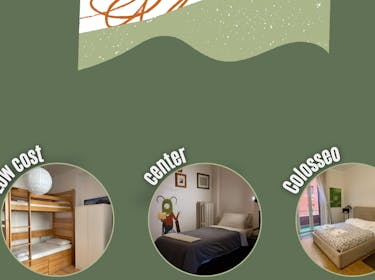Benvenuti a Il PlanctonRoman experience-Latin Style

Hostel Il Plancton
Camere
Mostra tuttoChi siamo
Ulteriori informazioniBenvenuti nel nostro angolo autentico e giovanile nel cuore di Roma! Nel nostro ostello fondiamo il fascino del passato con la vibrante energia del presente. Situato nella migliore posizione di Roma, vi diamo il benvenuto in uno spazio vintage che respira l'essenza della città eterna.
*Scoprire l'autonomia:*.Nel nostro ostello celebriamo l'autonomia e lo spirito di avventura. Grazie al facile accesso ai luoghi più emblematici di Roma, vi invitiamo a esplorare la città al vostro ritmo. Dal Colosseo alla Fontana di Trevi, ogni angolo storico è a portata di mano.
*Stile vintage e anticoImmergetevi nell'atmosfera unica di Roma, che si riflette anche nel nostro design. Con un tocco vintage e un aspetto antico che si fonde perfettamente con l'architettura romana, ogni angolo racconta una storia che si intreccia con la ricca storia della città.
Esperienza all'aperto con un tocco verde:Il nostro spazio comune esterno, con un piccolo giardino verde, è un'oasi spettacolare che offre una fuga tranquilla in mezzo al trambusto urbano. Godetevi i momenti di relax sotto il sole italiano o condividete le risate con gli altri viaggiatori mentre esplorate il nostro spazio esterno.
*Il miglior servizio a vostra disposizione:*.Il nostro team è qui per rendere il vostro soggiorno un'esperienza indimenticabile. Dalle raccomandazioni locali ai dettagli pratici, siamo pronti ad aiutarvi in ogni momento. Vogliamo che vi sentiate a casa, solo nella città più affascinante del mondo.
*Lasciatevi ispirare, mettetevi in contatto, esplorate.Questo non è solo un ostello, è un luogo dove le storie si intrecciano, dove sbocciano nuove amicizie e dove ogni giorno è un'opportunità per scoprire qualcosa di nuovo. Lasciatevi ispirare, entrate in contatto con altri viaggiatori ed esplorate Roma con noi.
Scegliete un soggiorno che va oltre il semplice alloggio. Venite nel nostro ostello e scoprite Roma da un punto di vista autentico e giovanile. Non siamo solo una scelta, siamo la vostra scelta a Roma, benvenuti nella vostra casa lontano da casa!



